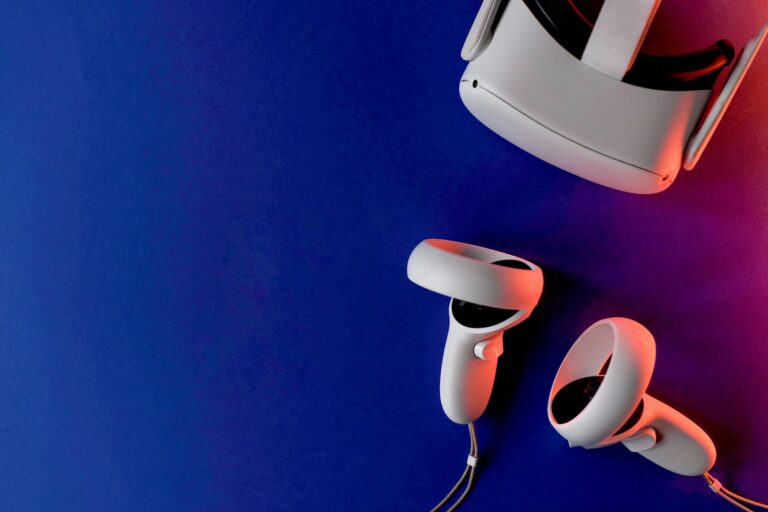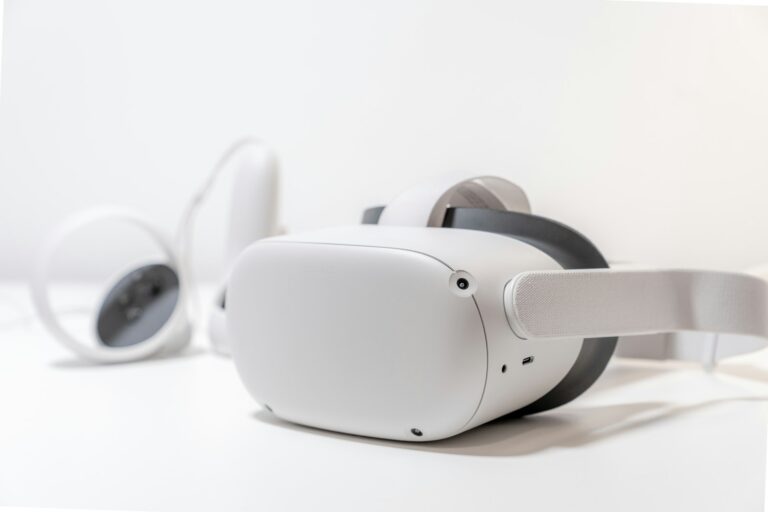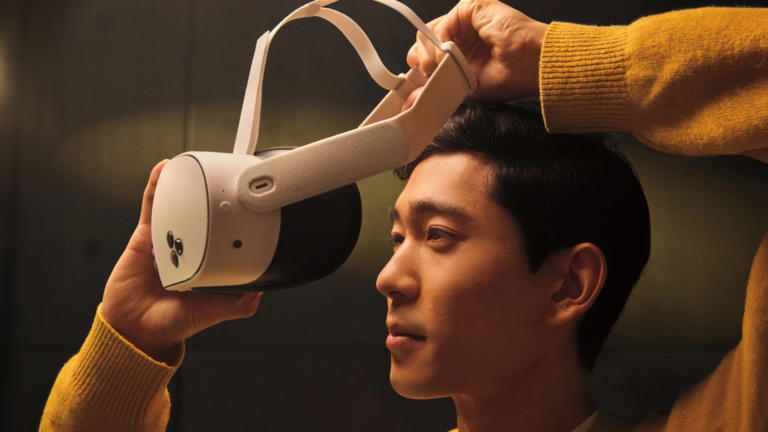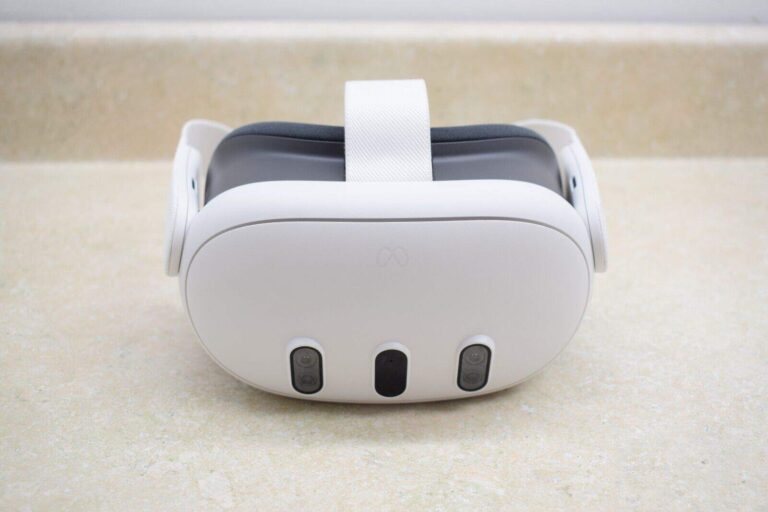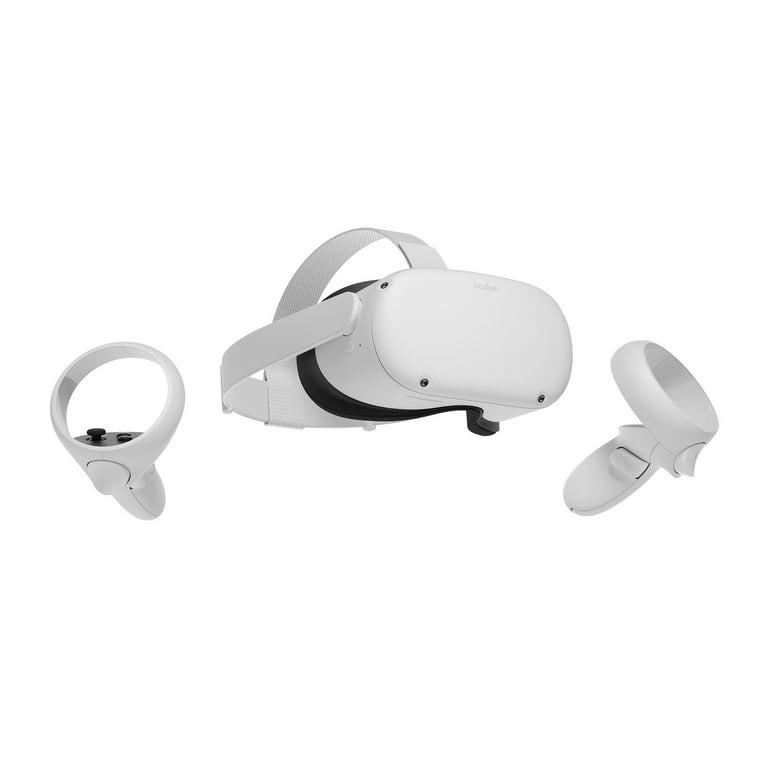
Virtual reality has become more accessible than ever, with several affordable options now available for those wanting to explore digital worlds without breaking the bank. Finding the right VR headset at a reasonable price means balancing features, comfort, and compatibility with your existing devices. The best budget VR headsets in 2025 offer impressive experiences starting at just $299, making virtual reality a realistic option for most tech enthusiasts.
When shopping for an affordable VR headset, you’ll want to consider whether you need a standalone device or one that connects to your PC or console. Companies like Meta have revolutionized the market with their Quest lineup, while other manufacturers offer competitive alternatives at various price points. Your ideal choice will depend on what games you want to play and how you plan to use your new virtual reality system.
1: Meta Quest 3S
The Meta Quest 3S stands out as the best cheap ticket to mixed reality, giving you impressive features at a budget-friendly price of $300. This affordable headset brings color passthrough cameras that let you see your real environment while using VR.
You’ll appreciate the improved graphics compared to older models like the Quest 2. The Quest 3S delivers a visual experience that’s noticeably better without breaking the bank.
For those of you wanting to enter the VR world without spending too much, the Quest 3S is the best affordable VR headset currently available. It includes almost all the newest features while keeping costs down.
When comparing budget options, experts consistently rank the Quest 3S as the best budget headset in 2025. The competition in this price range is limited, with few alternatives offering similar value.
If you’re trying to decide between models, consider that the Quest 3 uses pancake lenses which are superior, but it costs significantly more at around $700. The 3S provides a more affordable option at $450 while still delivering most of the important features.
The Quest 3S makes a perfect entry point if you’re new to VR or upgrading from older technology. You get modern VR capabilities without the premium price tag of higher-end models.
2: Sony PlayStation VR2
The PlayStation VR2 has recently become more affordable, with Sony announcing a price drop to $400 in March. This $150 reduction makes it a more attractive option if you’re looking for a premium VR experience without breaking the bank.
What makes the PSVR2 stand out is its impressive hardware capabilities. The headset delivers stunning visuals and immersive gameplay that can really showcase what modern VR has to offer.
For PlayStation 5 owners, this headset provides a seamless integration with your existing gaming setup. You’ll find the connection process straightforward as it’s designed specifically for the PS5 console.
The PSVR2 bundle with Horizon Call of the Mountain gives you immediate access to a game that fully demonstrates the headset’s capabilities. The game features detailed environments and immersive exploration that will pull you right into the action.
Interestingly, the PSVR2 can now work with compatible PCs using an adapter. According to Reddit users, this PSVR2 for PCVR option works with most applications, though some may not be fully optimized yet.
You can purchase the PlayStation VR2 directly from PlayStation’s online store, where you’ll find the headset, accessories, and compatible games all in one place.
3: HP Reverb G2
The HP Reverb G2 stands out as an excellent budget-friendly option for VR enthusiasts. With its impressive visual quality, this headset delivers one of the best looking VR experiences available at this price point.
You’ll appreciate the high-resolution display that makes games and simulations look crisp and detailed. The Reverb G2 is particularly well-suited for simulator games where you’re seated rather than moving around.
What makes this headset especially attractive is its recent price drops. While originally priced at $599, you can now often find it discounted to around $399, making it competitive with entry-level options.
The G2 comes with everything you need to connect to your PC right out of the box. This complete package means you won’t need to purchase additional accessories to get started.
Visual quality is where this headset truly shines. According to testing, the Reverb G2 offers better overall visual quality than many competing headsets, even some at higher price points.
The upgraded Version 2 model features improved tracking and comfort over the original release. These refinements make the G2 more user-friendly for extended gaming sessions.
Your comfort during longer VR sessions is enhanced by the headset’s balanced weight distribution and adjustable straps. The built-in speakers provide solid audio without the need for separate headphones.
4: Nintendo Labo Toy-Con 04
The Nintendo Labo Toy-Con 04 VR Kit offers one of the most affordable entries into virtual reality gaming. As a unique Nintendo Switch accessory, it combines DIY cardboard creations with simple VR experiences that won’t break your bank.
When you purchase the kit, you’ll receive cardboard templates to build your own VR goggles and various interactive toys. The building aspect bridges the gap between crafting and affordable virtual reality, making it both educational and entertaining.
You can choose between the full VR Kit or the Starter Set + Blaster option if you want to test the waters first. The Starter Set includes the VR goggles and blaster, while the complete kit adds more interactive Toy-Cons like a camera and elephant.
The experience is simple but engaging. You won’t find high-end VR graphics, but the tactile and fun virtual reality experience makes up for visual limitations. The Joy-Cons track your movements surprisingly well through the cardboard creations.
What makes this VR option special is the Toy-Con Garage VR feature. This tool allows you to create your own mini VR games and experiences, adding significant value to your purchase.
While Nintendo has discontinued the Labo VR line, you can still find kits online. For an inexpensive yet engrossing VR experience, the Nintendo Labo VR Kit remains a worthy consideration in the budget VR market.
5: Oculus Go
The Oculus Go offers a simple way to enjoy VR without breaking the bank. Released as one of the first standalone VR headsets, it doesn’t require a computer or phone to operate.
You can still find the Oculus Go at very affordable prices in 2025. Some people have found them for as little as $21 at flea markets, making it possibly the cheapest entry point to VR today.
The headset comes with crystal clear optics that make it feel more like a personal theater. It’s particularly good for watching videos and basic VR experiences.
Unlike more expensive options, the Go is designed for seated experiences. You won’t be able to walk around in virtual spaces, but this makes it perfect for simulator games and media consumption.
The standard model includes 32GB of storage, enough for several apps and videos. The battery typically lasts about 2-3 hours, sufficient for most VR sessions.
While the Oculus Go doesn’t offer the advanced features of newer headsets like the Meta Quest 3S, it remains a viable budget option if your needs are simple. Its lightweight design makes it comfortable for extended wear.
You’ll find the controller easy to use, with simple point-and-click functionality that works well for beginners. This accessibility makes it a good starter headset if you’re curious about VR but not ready to invest heavily.
6: HTC VIVE Virtual Reality System
The HTC VIVE Virtual Reality System offers a solid entry point for budget-conscious VR enthusiasts. While not the cheapest option available, it delivers reliable performance that makes it worth considering.
For those on a tight budget, you might want to look at the VIVE Focus Plus for $99, which is PCVR-compatible. This option requires some troubleshooting but gives you access to VR gaming without breaking the bank.
The standard VIVE system provides room-scale VR experiences with its versatile tracking features. You’ll need a decent PC to power it, which is something to factor into your budget calculations.
HTC offers several models in their VIVE Focus series that balance cost with performance. These headsets give you options for both standalone and PC-connected virtual reality experiences.
The display quality on VIVE headsets is quite good for the price point. You’ll enjoy crisp visuals that help create immersive gaming and entertainment experiences.
Controller tracking is precise, allowing you to interact naturally with virtual environments. This makes games more intuitive and enjoyable, even at a lower price point.
If you’re considering upgrading later, the VIVE ecosystem offers pathways to more premium experiences like the VIVE Pro 2. This makes the entry-level system a good starting investment in your VR journey.
7: Apple Vision Pro
The Apple Vision Pro is not what you’d call a budget VR headset. With a starting price of $3,499, it’s one of the most expensive consumer VR options available in 2025.
Apple markets this device as a “spatial computing” platform rather than just VR. The Vision Pro offers mixed reality capabilities that blend the virtual and real worlds in impressive ways.
While its technical specifications and build quality are impressive, the price tag puts it far outside the budget category we’ve been discussing throughout this article.
For comparison, the Meta Quest 3 costs significantly less while still offering solid mixed reality features. The Quest 3 remains the more affordable option if you want to try mixed reality.
There are rumors about Apple developing a cheaper Vision headset that might cost around $2,000. Even at that lower price point, it would still be much more expensive than what most would consider “budget VR.”
The Vision Pro showcases where VR/AR technology is heading, but its premium pricing makes it unsuitable for most consumers looking for affordable entry points into virtual reality.
If you’re curious about Apple’s approach to VR but don’t want to spend thousands, you might want to wait for potential price drops or more affordable models in the future.
8: Meta Quest Pro
The Meta Quest Pro represents a high-end option in the VR headset market, though it’s not typically considered a budget choice. If you’re looking to invest in premium VR technology, this device offers several advanced features.
The Meta Quest Pro features redesigned controllers with self-tracking cameras that eliminate the need for tracking rings. This design allows for greater range of motion and more precise finger control.
You’ll appreciate the enhanced capabilities for detailed interactions in VR. The controllers can translate fine motor movements like writing and drawing more accurately than budget models.
While the Meta Quest Pro offers premium features, you might want to consider the Meta Quest 3S if you’re specifically looking for a budget option. The 3S has been recognized as one of the best affordable VR headsets in 2025.
For movie watching on a budget, you might find the Meta Quest 2 at $199 offers better value than the Pro. The Quest 2 provides a good viewing experience without the premium price tag of the Pro.
The Pro model shines in professional and creative applications where precision tracking and advanced features justify the higher cost. Your choice ultimately depends on whether you need these premium capabilities or if a more budget-friendly option would meet your needs.
9: DPVR E4
The DPVR E4 stands out as a strong contender in the budget VR market. This PC-based headset offers impressive specs while keeping costs reasonable.
With four cameras positioned in the corners, the E4 provides 230° ultra-wide-angle coverage. This setup ensures accurate tracking for games like Beat Saber where precision matters.
You’ll find the DPVR E4 particularly well-suited for simulation experiences. Many users consider it the best affordable VR option for flight simulators, delivering solid performance without breaking the bank.
Racing enthusiasts have also tested the E4 with iRacing. Interestingly, some discovered that not running everything on low settings actually yielded better framerates than setting everything to minimum.
Comfort is another area where this headset performs well. The design prioritizes extended wear sessions, making it suitable for longer gaming or simulation experiences.
When comparing value propositions, the DPVR E4 delivers a great VR experience at a reasonable price point. You get access to PCVR capabilities without the premium cost of more established brands.
If affordability and performance are your priorities, the DPVR E4 Black deserves your consideration. It balances good specifications with budget-friendly pricing for those wanting to enter PCVR gaming.
10: PlayStation VR1
The PlayStation VR1 remains a solid budget VR option even in 2025. While newer headsets offer improved specs, PSVR1’s lower price point makes it an attractive entry point for VR gaming.
You’ll find the PSVR1 offers great value for money if you already own a PlayStation console. Its extensive game library contains many classics that still deliver enjoyable experiences today.
The headset works with both PS4 and PS5 consoles, though you’ll need an adapter for the latter. This backward compatibility extends the device’s usefulness, especially if you’ve upgraded your console.
Many users particularly enjoy the controller-based games like Astro Bot, Moss, and Wipeout. These titles showcase what makes PSVR1 special despite its aging technology.
The resolution is lower than newer headsets, but many games still look impressive inside the visor. You won’t get the crystal clarity of high-end options, but the immersion remains effective.
Setup requires some patience with multiple cables and connections. The tracking can be finicky at times due to the reliance on a single camera system.
If your budget is tight but you want to experience VR gaming, the PSVR1 still offers an inexpensive way to get started. You can often find units at significant discounts, making it even more affordable as newer technology has emerged.
Understanding VR Technology
Virtual reality technology creates immersive digital environments that users can interact with. The systems combine specialized hardware and software to trick your brain into believing you’re somewhere else entirely.
How VR Works
VR works by replacing your real-world sensory input with computer-generated information. The headset displays slightly different images to each eye, creating a stereoscopic 3D effect that mimics natural vision.
When you move your head, motion sensors (accelerometers and gyroscopes) track these movements. The VR system then adjusts what you see in real-time, creating the illusion that you’re looking around a virtual world.
Most VR systems run at least 72 frames per second to reduce motion sickness. Your brain needs smooth visual feedback that matches your physical movements.
Advanced systems also incorporate spatial audio that changes based on head position. This audio positioning helps your brain accept the virtual environment as “real.”
Key Components of VR Systems
Headsets/HMDs: The Meta Quest 3S and PlayStation VR2 are popular budget options. These devices contain displays, lenses, and motion sensors.
Displays: Budget VR headsets typically use LCD or OLED screens. Higher resolution displays (measured in pixels per eye) provide clearer images and reduce the “screen door effect” where you can see gaps between pixels.
Tracking Systems: VR headsets use different tracking methods:
- Inside-out tracking: Cameras on the headset track your movement
- Outside-in tracking: External sensors monitor your position
Controllers: These handheld devices let you interact with virtual objects. Budget options like the Quest 3S controllers provide haptic feedback that vibrates when you touch virtual objects.
Processing Power: Some headsets like Pimax Crystal Light require connection to a powerful PC, while standalone options have built-in processors.
Factors to Consider When Choosing Budget VR
Finding the right budget VR headset requires balancing several key elements to ensure you get the most value without compromising your experience. Your decision should weigh performance against cost, device compatibility, and physical comfort during extended use.
Performance vs. Price
When shopping for budget VR headsets, you need to identify what performance aspects matter most to you. Resolution is crucial—higher pixel counts (ideally 1832 × 1920 per eye or better) provide clearer images and reduce the “screen door effect” that can break immersion.
Refresh rate affects how smooth motion appears in VR. Even budget options should offer at least 72Hz, while 90Hz is preferable for reducing motion sickness. Consider your intended use when deciding which performance aspects to prioritize.
Field of view (FOV) determines how much of the virtual world you can see simultaneously. Budget headsets typically offer 90-100 degrees, while premium models reach 110+ degrees. A wider FOV creates a more immersive experience.
Be realistic about performance expectations. Budget headsets may offer fewer features than high-end models but can still deliver enjoyable experiences for casual gaming and media consumption.
Compatibility and Accessibility
Budget VR headsets come in two main types: standalone and PC-connected. Standalone headsets like the Meta Quest series work without additional hardware, making them more accessible for beginners. PC-connected headsets require compatible computers but often deliver better graphics.
Check system requirements carefully. PC-connected headsets need:
- Processor: At least Intel i5 or AMD Ryzen 5
- Graphics: NVIDIA GTX 1060 or better
- RAM: Minimum 8GB, 16GB recommended
- Ports: HDMI or DisplayPort, USB 3.0
Content availability varies between platforms. Research which games and applications you want to experience and ensure your chosen headset supports them.
Consider future compatibility and upgrade paths. Some budget headsets offer expansion options like PC connectivity for standalone models.
Comfort and Ergonomics
VR sessions can last hours, making comfort essential. Weight distribution affects neck strain—look for headsets under 600 grams with balanced weight distribution.
Adjustability features to consider include:
- Interpupillary distance (IPD) adjustment
- Headband tension mechanisms
- Face cushion materials and replaceability
Proper fit is crucial for both comfort and optimal visual experience. Glasses compatibility varies between models—some include spacers or have enough room built-in, while others may require prescription lens inserts.
Heat management affects comfort during longer sessions. Look for designs with ventilation or materials that minimize sweat buildup.
Try before buying if possible. Everyone’s head shape and comfort preferences differ, so what works for others might not work for you.
Frequently Asked Questions
Budget VR headsets offer a range of options for different needs and platforms. Price points vary widely, with significant differences in quality, features, and compatibility.
What are the most cost-effective VR headsets currently available for PC gaming?
For PC gaming on a budget, the HP Reverb G2 offers excellent value. It provides high-resolution displays and comfortable fit at a more accessible price point than many competitors.
The Reverb G2 delivers impressive visual clarity with its 2160×2160 per-eye resolution, making it ideal for detailed PC games and simulations.
You’ll need a decent gaming PC to power it, but the headset itself costs significantly less than premium options while delivering better visual quality than many mid-range alternatives.
Which affordable VR headset is compatible with smartphones?
The Nintendo Labo Toy-Con 04 offers an ultra-budget option that works with smartphones. Several basic VR viewers are available for under $50 that can transform your existing phone into a simple VR display.
These phone-compatible options often use your smartphone’s processing power and display, making them much more affordable than standalone units.
You can find options like Google Cardboard-style viewers that cost as little as $15-30, providing a basic VR experience for casual users or those wanting to try VR before investing in a higher-end system.
Are there any budget VR set options that include motion controllers?
Yes, the Meta Quest 3S includes motion controllers at a budget-friendly price point. This headset offers a complete package with hand tracking and motion controllers included.
The controllers allow you to interact naturally with virtual environments, grabbing objects and performing actions intuitively.
Even at lower price points, many modern VR systems now include some form of motion control, as it’s become a standard feature expected by most users.
How does the performance of lower-priced VR sets compare to more expensive ones like the Quest 2?
Lower-priced VR headsets typically offer reduced resolution, narrower field of view, and less sophisticated tracking compared to mid-range options like the Quest 2. Budget headsets may have more limited content libraries and fewer features.
Visual quality is often the most noticeable difference, with budget options displaying lower resolution images that might appear pixelated or less detailed.
Tracking accuracy can also differ significantly, with premium headsets offering more precise movement detection and positioning than their budget counterparts.
What should consumers look for in a budget VR headset in terms of features and specifications?
When shopping for budget VR, prioritize comfort, adequate resolution (at least 1080×1080 per eye), and compatibility with your existing devices. Consider what content you want to access and ensure the headset supports it.
Look for a refresh rate of at least 72Hz to avoid motion sickness, which can be common with lower refresh rates.
Battery life is another crucial factor for standalone headsets, with a minimum of 2-3 hours being acceptable for most casual users.
Can users expect a quality virtual reality experience from cheaper VR headsets?
Yes, even budget VR headsets can deliver enjoyable experiences, particularly for casual gaming, video viewing, and simple applications. The Oculus Go, though older, still provides a solid entry-level experience.
Expectations should be adjusted accordingly—you won’t get the same experience as a $1000+ setup, but many users find budget options perfectly satisfying for their needs.
The technology has advanced enough that even affordable headsets now offer experiences that would have been premium features just a few years ago.

